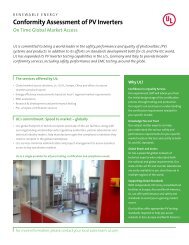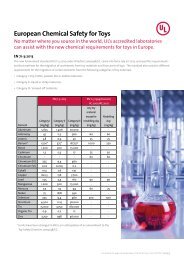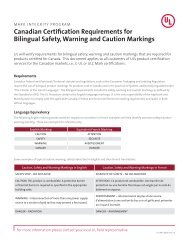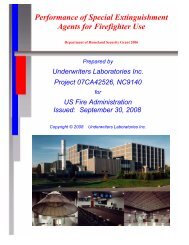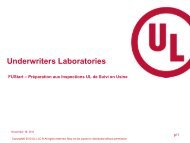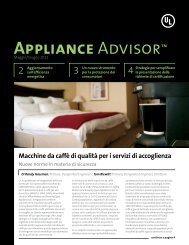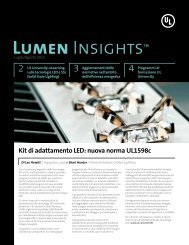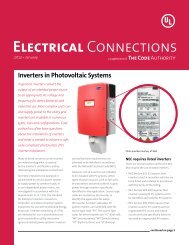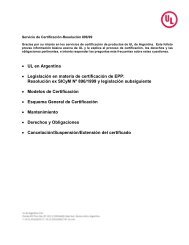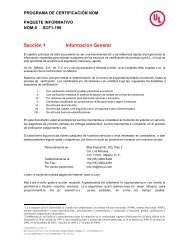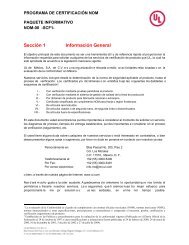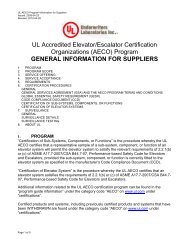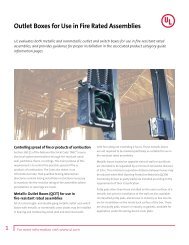Alternate Power Source System Codes - UL.com
Alternate Power Source System Codes - UL.com
Alternate Power Source System Codes - UL.com
You also want an ePaper? Increase the reach of your titles
YUMPU automatically turns print PDFs into web optimized ePapers that Google loves.
<strong>Alternate</strong> <strong>Power</strong> <strong>Source</strong><br />
<strong>System</strong> <strong>Codes</strong><br />
Emergency, standby, legally required systems and a fire pump too…<br />
The application requirements for today’s alternate<br />
power sources are still largely dependent<br />
upon engine driven generator systems.<br />
Installations can be single or multiple installed<br />
in a parallel configuration determined by load<br />
requirements and critical system needs.<br />
These are problems designers face and<br />
choices to make when developing an<br />
alternate power source system for a structure.<br />
Proper generator selection is not as simple<br />
as selecting the low bid price. In fact, it can<br />
involve the application of numerous codes<br />
and standards. As an example, Section<br />
2701 of the 2009 International Building Code<br />
(IBC) states that required emergency and<br />
standby power systems are to be installed in<br />
accordance with the NFPA 110 and NFPA 111<br />
standards. In addition, Section 2702.1.1 of<br />
the IBC requires that emergency and standby<br />
stationary generators be listed in accordance<br />
with <strong>UL</strong> 2200, the Standard for Safety of<br />
Stationary Engine Generator Assemblies. <strong>UL</strong><br />
White Book category FTSR covers Stationary<br />
Generators Listed to <strong>UL</strong> 2200. These generators<br />
are rated 600 V or less and are intended<br />
for installation and use in accordance with:<br />
• NFPA 70 “National Electrical Code”<br />
• NFPA 37 “Standard for the Installation<br />
and Use of Stationary Combustion<br />
Engines and Gas Turbines”<br />
• NFPA 99 “Standard for Health<br />
Care Facilities”<br />
• NFPA 110 “Standard for Emergency<br />
and Standby <strong>Power</strong> <strong>System</strong>s”<br />
The need for any <strong>UL</strong> 2200 Listed generator<br />
serving as an alternate power source begins<br />
with the simple decision of which systems need<br />
power when a utility <strong>com</strong>pany goes off line.<br />
This is determined using Article 220 of<br />
the 2008 National Electrical Code (NEC)<br />
and a precise load calculation to establish<br />
the actual building load the generator<br />
must supply as required by NEC Sections<br />
695.3(B)(1), 700.5, 701.6 and 702.5. Again,<br />
numerous codes and standards must be<br />
applied to an installation, based on building<br />
occupancy, use, and content loading. States<br />
and municipalities typically adopt the numerous<br />
codes and standards that must be considered<br />
for proper installation such as:<br />
• Building Code<br />
• Life Safety Code<br />
June 2010<br />
For regulatory authorities in the electrical inspection <strong>com</strong>munity.<br />
• Health Care Standard (for Medical Facilities)<br />
(continued)
Electrical Connections<br />
a supplement of The Code Authority ®<br />
<strong>Alternate</strong> <strong>Power</strong> <strong>Source</strong> <strong>System</strong> <strong>Codes</strong> (continued)<br />
• Fire Code<br />
• Sprinkler Code<br />
• Fire Pump Code<br />
• National Electrical Code<br />
What is unique about installing emergency<br />
and standby power systems is that often<br />
codes applicable to an installation, will<br />
reference and require the use of a second,<br />
third, or even a fourth code or standard.<br />
The <strong>com</strong>bination of codes and standards<br />
determines the entire set of requirements for<br />
a proper installation of a specific generator<br />
system and its unique <strong>com</strong>ponents and<br />
features. These codes and standards may<br />
have separate requirements, but they are all<br />
intended to work in harmony and impact the<br />
overall decision to make a code <strong>com</strong>pliant<br />
installation. Here is a basic example:<br />
A building under design is required by Section<br />
903 of the IBC to have a sprinkler protection<br />
system installed in accordance with NFPA<br />
13, the Standard for Sprinkler <strong>System</strong>s.<br />
The municipal water system supplying the<br />
building has inadequate pressure to make the<br />
sprinkler system design feasible. A fire pump<br />
is designed into the system as an acceptable<br />
water supply source to increase water<br />
pressure for the sprinklers. The designer<br />
specifies a fire pump that <strong>com</strong>plies with NFPA<br />
20, the Standard for Fire Pumps and required<br />
by NFPA 13 and Section 913 of the IBC. The<br />
fire pump now be<strong>com</strong>es part of the design<br />
requirement for the required sprinkler system.<br />
This <strong>UL</strong> 2200 Listed generator will<br />
supply three individual <strong>UL</strong> Listed<br />
transfer switches evaluated to<br />
<strong>UL</strong> 1008, Standard for Safety of<br />
Published by the Regulatory Services<br />
Department of Underwriters Laboratories Inc.<br />
© 2010. All rights reserved.<br />
Transfer Switch Equipment, to provide backup<br />
power to critical circuits. Additional information<br />
on transfer switches may be located in the <strong>UL</strong><br />
White Book under categories:<br />
• WPTZ — Transfer Switches<br />
• WPWR — Automatic Transfer Switches<br />
for use in Emergency <strong>System</strong>s<br />
• XNVE — Transfer Switches for use in<br />
Fire Pump Motor Circuits<br />
The fire pump disconnect must be a<br />
supervised connection as required by Section<br />
695.4 of the NEC and clearly marked in<br />
at least one inch letters — as “Fire Pump<br />
Disconnecting Means,” with overcurrent<br />
protection that can carry locked rotor current<br />
indefinitely, and located some distance away<br />
to assure adequate physical separation<br />
from the other disconnects in accordance<br />
with NEC Sections 695.4(B)(1), (2), (3), (5),<br />
695.6(C) and NFPA 20. From this supervised<br />
switch, feeder conductors are sized to 125<br />
percent of the full load current of a fire pump<br />
motor, pressure maintenance pump plus 100<br />
percent of any other associated equipment if<br />
supplied by this feeder per the requirements<br />
of NEC Section 695.6(C)(1). This application<br />
<strong>com</strong>plies with both NEC Articles 695 and<br />
700. The use of a vertical switchboard with<br />
separate sections is not permitted in a single<br />
generator installation due to the requirements<br />
of the NEC Sections 695.4(A) and (B)(2).<br />
Generator selection and sizing is only one of<br />
the many factors that designer’s face. NFPA<br />
20 and NEC Section 695.7 include<br />
requirements that the voltage at<br />
controller line terminals shall not<br />
drop more than 15 percent below<br />
normal (controller-rated voltage)<br />
under motor-starting conditions, and<br />
the voltage at the motor terminals<br />
shall not drop more than 5 percent<br />
below the voltage rating of the<br />
motor when it is operating at<br />
115 percent of the full-load<br />
current rating of the motor. This<br />
requires careful load calculation<br />
and generator sizing to<br />
ac<strong>com</strong>modate all loads that must<br />
Managing Editor: Jeffrey A. Fecteau<br />
+1.651.408.8562<br />
Jeffrey.Fecteau@us.ul.<strong>com</strong><br />
www.ul.<strong>com</strong>/tcaec<br />
<strong>UL</strong><br />
June 2010<br />
be served, and the fire pump started with no<br />
dip in voltage. If this proves problematic, load<br />
shedding on start up to eliminate voltage drop<br />
at the controller terminals be<strong>com</strong>es mandatory.<br />
Emergency and legally required standby<br />
generator systems must have a witness<br />
and load test prior to issuing a certificate<br />
of occupancy for a building as required by<br />
NEC Sections 700.4(A), (E) and 701.5(A), (E).<br />
The witness and load test are required to<br />
ensure that a generator listed to <strong>UL</strong> 2200<br />
is properly sized and installed to carry all<br />
required loads. In addition to the previously<br />
mentioned requirements, NEC Section 695.10<br />
requires fire pump equipment must be listed;<br />
additional information is located in the <strong>UL</strong><br />
White Book under categories:<br />
• QXZF — Fire Pump Motors<br />
• QYZS — Fire Pump Controllers<br />
• QVUT — Pumping Equipment for<br />
Fire Service<br />
As the example illustrates, designers often face<br />
<strong>com</strong>plex issues when designing power supply<br />
systems for fire pumps. Often what seems<br />
like a <strong>com</strong>mon sense approach may not be<br />
truly code <strong>com</strong>pliant. Careful consideration of<br />
the above-mentioned codes and standards is<br />
essential to a code <strong>com</strong>pliant design and to<br />
receive the approval of the code authorities<br />
from all the interested disciplines.<br />
For more information about <strong>UL</strong> Listed<br />
generators or <strong>UL</strong> Listed transfer switches,<br />
please contact Donnie Shields at<br />
+1.847.224.2760 or Donald.Shields@us.ul.<strong>com</strong>



